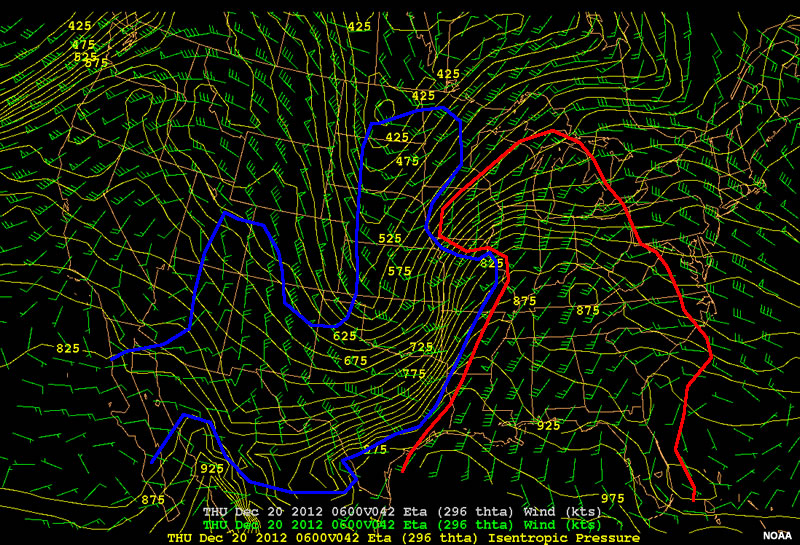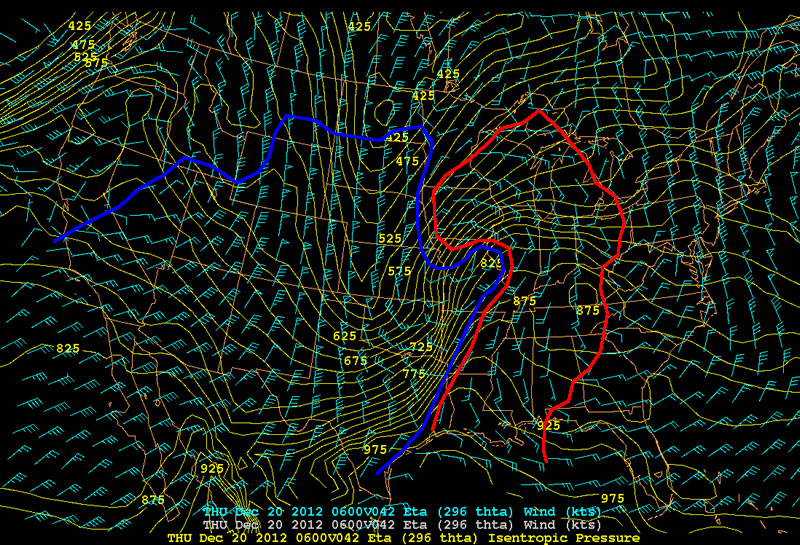Pre-Lab: Understanding Potential Temperature as a Tool to Diagnose Vertical Motion
Finally, and perhaps most importantly, isentropic analysis is viewed by many as a preferred tool for analyzing and diagnosing synoptic scale ascent and descent.
In standard pressure-coordinate map analyses, vertical ascent can be diagnosed, but in a piecewise, or “ladder” sense across multiple pressure level maps. Upward motion and moisture/precipitation generally appear to be separated from the advection that caused them on a single pressure level!
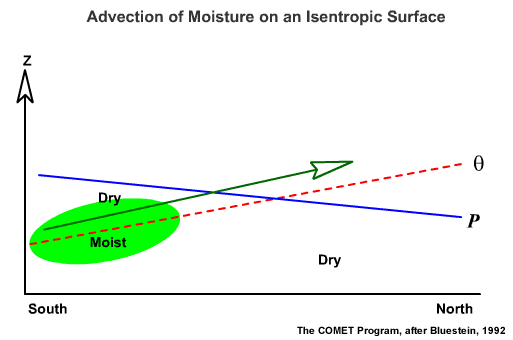
In the diagram above, we have a generic situation in which warm, moist air is slowly ascending to the north in a warm conveyor belt. Looking at the region using the standard pressure level, p, over time, the moisture would seem to appear from nowhere as it emerges from a lower pressure level.
But if we examine the region using isentropic surfaces, we can view the advection and ascent that are causing the precipitation together in the same chart. The moist air parcel above appears to naturally follow the isentropic surface! This is similar to what we saw in the cross-section views of fronts earlier - cold air will flow to the south and downward, while warmer air will flow to toward the north and upward, following the shape of the isentropes (until latent heat is released, that is).
In fact, in absence of diabatic processes and mixing, air will flow along potential temperature surfaces, since potential temperature is conserved during adiabatic processes. In this way, air parcels with a specific potential temperature value are restricted to flow along the isentropic surface of that value, much as with a material surface.
Thus, we can plot wind vectors and contours of pressure on a specific potential temperature surface to see just how much air is ascending or descending.
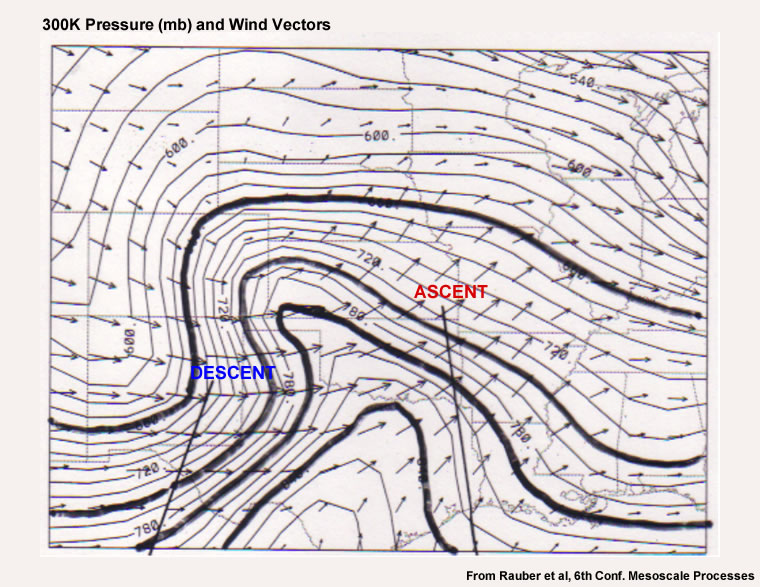
In the above diagram of pressure and winds plotted on the 300K isentropic surface, we can see broad westerly/northwesterly flow that defines the dry conveyor belt along with broad southwesterly flow that defines that warm conveyor belt. If we examine the pressure levels closely, we see values of 600 mb in western New Mexico, which is within the dry conveyor belt. Wind barbs indicate that air is flowing to the east on this isentropic surface. We can see that the pressure values increase dramatically between this area and the panhandle of Texas. Neglecting diabatic processes, this means that the air in this region on the 296K surface must be sinking!
We can see a similar but opposite process within the warm conveyor belt. Pressure values are about 780 mb over Louisiana, and winds are flowing across progressively lower pressure levels to the northeast, reaching 700 mb over central Missouri. Neglecting diabatic processes, this means that air on the 300K surface is rising, since the pressure is decreasing! Including diabatic processes, the rising motion would be even more pronounced!
Looking at another example, let’s analyze the areas of ascent and descent on the 296K surface.
Question 1 of 2
Outline the full extent of the area of ascent using the red pen, and descent using the blue pen.
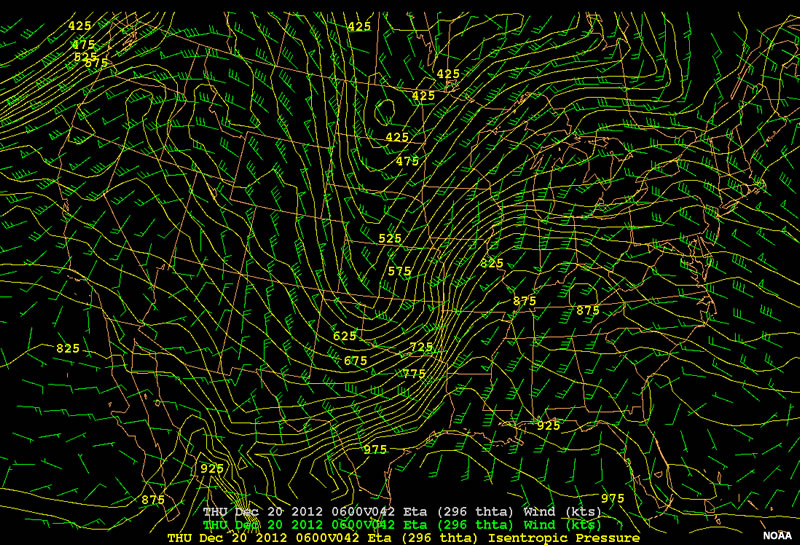
| Tool: | Tool Size: | Color: |
|---|---|---|
The area outlined in blue shows descent, beginning with the northwesterly winds that cross the 425 mb through 625 mb contour across the Great Plains. These winds flow to progressively higher pressures until the 825 mb contour over Missouri, Arkansas and Texas, where the winds become parallel to the contours and the pressure values begin to increase to the east. The area outlined in red shows ascent, from the 975 mb contour over the Gulf Coast, flowing to progressively lower pressures until the about the 600 mb contour over Iowa, Wisconsin and Michigan.
Let's compare this type of analysis with a standard pressure level chart. Below, pressure is plotted on the 305K surface. The warm and cold conveyor belts associated with the low pressure system are denoted with the long red and blue arrows, respectively.
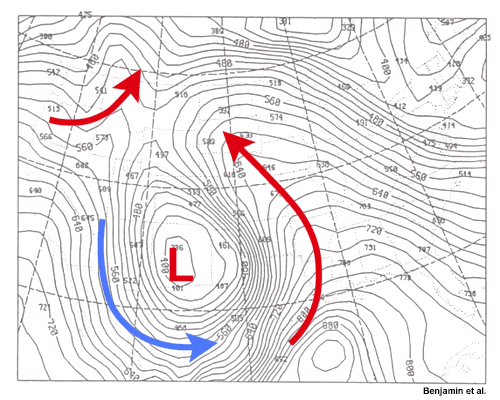
Now we'll examine the relative humidity field at 305K. High relative humidity, and thus cloud production, aligns very well with the axis of ascent within the warm conveyor belt

For comparison, let's now look at relative humidity plotted on the 500 mb pressure surface. 500 mb is a suitable choice here, as the range of pressures at 305K was approximately 400 mb to 700 mb over much of the domain. Quickly, we can see that the areas of high relative humidity do not align with areas of ascent that we saw earlier. If we examined additional pressure surfaces we would likely be able to "connect the dots" and envision a sloped ascent between the various RH maxima on each level - but clearly, isentropic analysis provides a more comprehensive and intuitive view of ascent in this case.

To enhance our view of conveyor belts and ascent/descent, we can view system relative winds instead of total wind as in the previous examples.
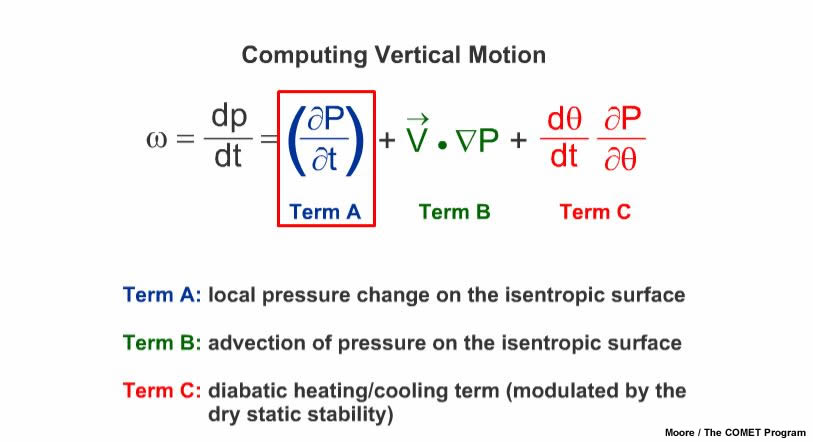
Typically, where wind speeds are large and directed along the pressure gradient, the advective change (term 2 above) will dominate the other terms (Saucier, 1955) and therefore yield a reasonable estimate of significant synoptic scale vertical motion. Typical methods of calculating the system-relative wind are to subtract a system-relative motion vector from the total wind. This is accomplished by tracking the vorticity center on the given isentropic surface for a number of hours (usually 6 to 12), or tracking the position of the shortwave trough on the isentropic surface.
The latter system-relative motion calculation was performed for the 296K level that we examined earlier. Let's take a look at the implications for the system, with system-relative wind barbs plotted in the question below.
Question 2 of 2
Outline the full extent of the area of system-relative ascent using the red pen, and descent using the blue pen.
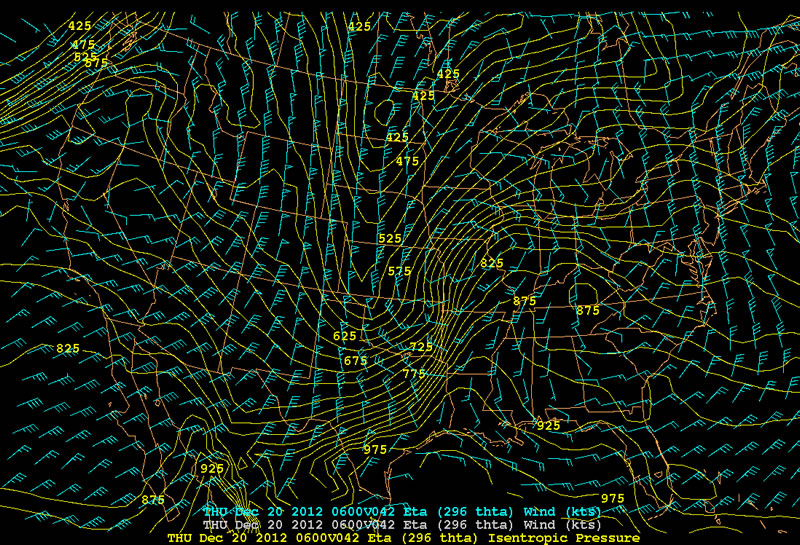
| Tool: | Tool Size: | Color: |
|---|---|---|
The red area of ascent and blue area of descent look similar to what we outlined earlier with ground-relative total winds. However, if we examine the strength and direction of the descent and ascent, we see a different picture. The system-relative winds in the second case show the wrap-around flow within the TROWAL much more clearly, while the descent is much more channeled behind the northern and central portion of the cold front, as we would expect from classical norwegian cyclone model and conveyor belts. Thus, these system-relative defined axes of strong ascent and descent are better predictors of where precipitation development is most likely.
Now that we have seen several uses for and ways to plot potential temperature and equivalent potential temperature, we will move forward with examining a midlatitude cyclone in a more isentropic sense in the lab activity. Some information, such as selecting the most appropriate isentropic surface, and moisture variables for use with isentropic analysis, was not covered in detail here, but can be found within the Isentropic Analysis webcast by Jim Moore here: https://www.meted.ucar.edu/training_module.php?id=94
